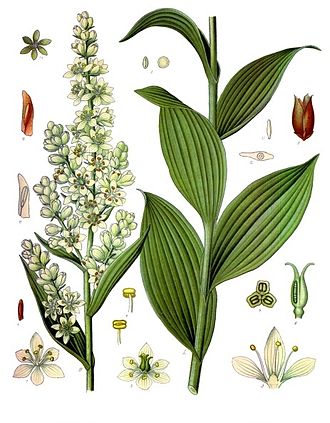Veratrum

Veratrum is a genus of flowering plants in the family Melanthiaceae.[3] It occurs in damp habitats across much of temperate and subarctic Europe, Asia, and North America.[2][4][5][6][7]
Veratrum species are vigorous herbaceous perennials with highly poisonous black rhizomes, and panicles of white or brown flowers on erect stems.[8] In English they are known as both false hellebores and corn lilies. However, Veratrum is not closely related to hellebores, corn, or lilies.
Veratrum species contain highly toxic steroidal alkaloids (e.g. veratridine) that activate sodium ion channels and cause rapid cardiac failure and death if ingested.[9] 2-deoxyjervine is also found in the plant and is known to cause cyclopia.[10] All parts of the plant are poisonous, with the root and rhizomes being the most poisonous.[9] Symptoms typically occur between thirty minutes and four hours after ingestion and include nausea and vomiting, abdominal pain, numbness, headache, sweating, muscle weakness, bradycardia, hypotension, cardiac arrhythmia, and seizures.[9] Treatment for poisoning includes gastrointestinal decontamination with activated charcoal followed by supportive care including antiemetics for persistent nausea and vomiting, along with atropine for treatment of bradycardia and fluid replacement and vasopressors for the treatment of hypotension.[9]
The toxins are only produced during active growth. In the winter months, the plant degrades and metabolizes most of its toxic alkaloids. Native Americans harvested the roots for medicinal purposes during this dormant period.
Native Americans used the juice pressed from the roots of this plant to poison arrows before combat. The dried powdered root of this plant was also used as an insecticide.[11] Western American Indian tribes have a long history of using this plant medicinally, and combined minute amounts of the winter-harvested root of this plant with Salvia dorii to potentiate its effects and reduce the toxicity of the herb. The plants’ teratogenic properties and ability to induce severe birth defects were well known to Native Americans.[11]
